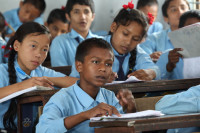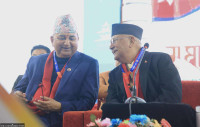Opinion
The Asian connection
Improving connectivity is the way to push economic growth in this part of the world
Binoj Basnyat
The recent incident in Uri in Indian-administered Kashmir where 18 Indian soldiers were killed reflects the unstable environment in South Asia. But at the same time, common understanding over regional connectivity has been growing in the last few years. Collective efforts are being made in the area of energy as shown by the Central Asia-South Asia transmission line project (CASA-1000) and the Turkmenistan, Afghanistan, Pakistan and India gas pipeline project (TAPI) being developed by the Asian Development Bank (ADB). However, one thing that needs to be considered is whether India has excluded Pakistan or if it is the other way around.
Growing communication links and road and rail infrastructure in Central, South and Southeast Asia are transforming the way countries in the
region connect with each other. The web of multilateral and multi-level diplomatic engagements on energy exports, trade and transportation has created important pathways for greater regional connectivity. While the economies of China and India have been growing rapidly, South Asia remains the least economically integrated part of the world.
Regional connectivity and integration plays a vital role. The US sees it as the New Silk Road initiative, a vision put forth in 2011 by the then secretary of state Hillary Clinton; and China sees it as the One Belt One Road (OBOR) initiative. The New Silk Road initiative seeks to promote greater connectivity by improving trade and transit, developing regional energy markets, strengthening customs and border operations and fostering deeper people-to-people and business relationships. Regional economic connectivity between Central, South and East Asia will further economic development and bolster peace and stability in a volatile region. Encouraging ownership
and participation by countries in the region has been driving the agenda forward to further shape, structure and fund the effort.
South Asia is on track to see several epoch-making developments. The China-Pakistan Economic Corridor (CPEC) was launched recently as the high point of their relations. Likewise, India and China have initiated many strategic infrastructure projects, namely the Silk Road Economic Belt, 21st Century Maritime Silk Road, Kunming initiative, Asian Highway and the Trans-Asian Railway. The establishment of the Asian Infrastructure Investment Bank (AIIB) under their initiative is another example.
Five key areas
Nepal is a geo-strategically significant landlocked country in the Himalaya which can be described as the world’s highest bridge between India and Tibet of China. Nepal sits between the two of the largest countries, armies, populations and economies in the world in the north and south respectively. Nepal has emerged from an isolated agrarian society and pursued greater economic integration with its neighbours. Therefore, the question before the country is how all this connectivity and integration affects it. How will Nepal take advantage of the economic possibilities and be part of the region?
There are five key areas that it needs to look into. Creating a regional energy grid will allow Nepal to sell its potential surplus electricity to power-starved South Asia. Water is going to replace
oil as the new strategic product; but unlike oil, water has no known substitute, making it more valuable from a long-term investment perspective.
The rise of the bottled water industry since the late 1990s is testimony to
how the golden age of cheap bountiful water has come to an end. If this is the global situation, imagine how much worse it would be in Asia where the per capita fresh water availability is not even half the world average. Water in the 21st century will be what oil was in the 20th century.
The third area is trade and transport. This involves building hard infrastructure like roads, railways and bridges and soft infrastructure like trade agreements, cross-border trade agreements, customs agreements and technical cooperation. You can have roads, bridges and railways, but you cannot have trucks and trains lined up on either side of the border. Therefore, faster customs and border procedures are required for doing business more efficiently. The goal here is to find ways to reduce the cost of doing business, border crossing time and overall transit time on either side. Border and customs harmonisation is required. Obviously, issues related to security, narcotics and other illegal acts remain a challenge, but ultimately political will is the way to resolve them.
The fifth and final area is developing people-to-people contact. This effort has seen tremendous success in the South Asian region, and it is very interesting to see things moving with the creation of networks through entrepreneurs, women entrepreneurs, businesses and youths. Engagement through educational institutions for higher education and vocational training besides construction of communication infrastructure will play a crucial role on this front.
Most important barrier
However, unsubstantiated political associations in a number of countries in the region, unfavourable security backgrounds and poor road and rail networks still remain key challenges to improving connectivity. The absence of normalised relations between India and Pakistan is the single most important barrier. Regulatory issues and politics have also prevented China and India from exploiting their full trade potential.
So far, all the notable initiatives directed at regional connectivity have remained inadequate. While such public sector schemes are important, they frequently suffer from bureaucratic disinterest and can be held captive by political associations among regional states. The whole programme has
to be driven by actors in the region and international lenders like the World Bank and the ADB. Regional connectivity and integration has enormous potential for increasing growth in the region. This region is home to 40 percent of the world’s poorest people, so for growth to pick up speed, a million jobs have to be created every month to meet the international target to eliminate poverty by 2030.
Basnyat is a retired Nepal Army Major General and holds an MPhil in defence and strategic studies




 10.12°C Kathmandu
10.12°C Kathmandu










